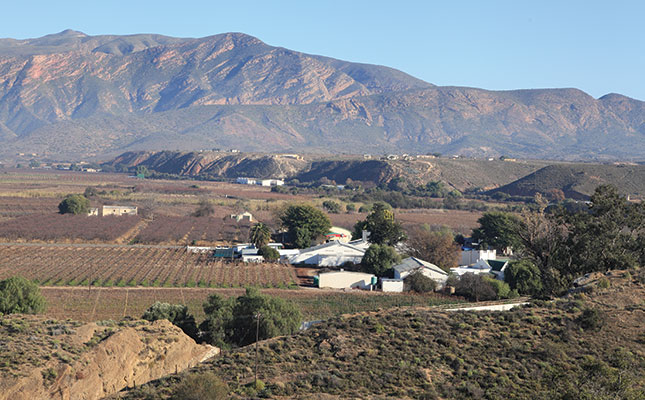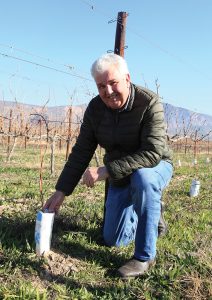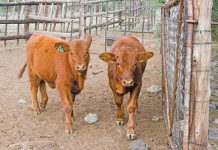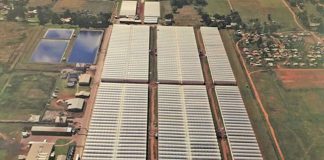
Photo: Glenneis Kriel
Boets Nel, co-owner with his brother Stroebel of De Krans Wines near Calitzdorp in the Western Cape, is blunt in his assessment of the effects of the region’s recent devastating drought.
The drought, which started in 2016, “was the worst in the history of the Klein Karoo, as bad as the one that ran from 1915 to 1918. It resulted in our farm, De Krans, losing 40% of its vineyards and 30% of its fruit trees.
“We stopped all our activities in orchards and vineyards older than 20 years to save as many of our younger, more lucrative vineyards as possible.
“Many of the old vineyards would have been replaced over the next few years anyway. It’s just challenging financially when so many vineyards need to be replaced at the same time after the drought has broken.”

Production fell from 600t to just more than 200t during the worst part of the drought, and the winery was forced to buy-in wine grapes for the first time in its history. Production has since increased to 350t.
“Grape prices, fortunately for us, were under pressure, but it was still a difficult decision, as I didn’t think we’d be able to get wine grapes that matched our quality and unique taste,” he says.
The Nels sourced grapes mainly from the Klein Karoo region and paid a premium to be allowed to get involved in the production of the grapes so that they could be assured of top quality.
Climate conditions have improved over the past few months, and their production objective for now is to fill the gaps left by dead trees and vines in the remaining orchards and vineyards. Some of the vineyards are too old to justify the interplanting of plant material, so the side branches of existing vines will be allowed to grow longer over the trellises to cover a wider area.
Deep roots
The drought, nonetheless, enabled them to gain valuable insights, some of which go against modern production trends. For one, they found that vines under flood irrigation proved more drought-resistant than those under micro-sprinklers.
“We have a Palomino vineyard planted in 1966 on deep alluvial sandy lime soils. The vineyard didn’t receive any water for two years, and paid for this with a drop in production from around 35t/ ha to 12t/ ha, but every vine survived,” says Nel.
The vineyards are irrigated from October to December, with vines under flood irrigation receiving roughly 50mm of water per vine once a month, or every other month, depending on the availability of water, during this time. This deep, infrequent irrigation forces the roots of the vines to grow up to 7m deep in search of water.
Vines under micro-sprinklers receive smaller volumes at least once every two weeks, and their roots rarely grow more than a metre deep, if that. This is especially problematic during water shortages or heatwaves, as the top layer of the soil usually dries more rapidly than the deeper layers.
Although Nel does not use drip irrigation, he says the roots of vines under drip irrigation will be even more vulnerable, as they are concentrated close to the droppers.
“People talk about efficient irrigation management and drip irrigation to pull you through a drought, but that won’t mean a thing if you don’t have any water, as happened to us from November to January in 2017/18 and 2018/19,” he says.
Another insight relates to the drought resistance of different rootstocks. Nel says the farm mainly used Richter 99 as a rootstock in the past, but switched to 101-14 from the 1980s, as the latter results in less vigorous growth.
During the drought, he discovered that the roots of 101-14 did not grow as deep as Richter 99, which rendered the variety more susceptible to climate shocks.
Climate proofing
The Nel family have done much work to ‘climate proof’ their farm. They receive only about 200mm of rain during normal years, with most of this falling either from March to May, or August to October. If lucky, they also experience a thunderstorm or two, usually in January or February.
Over the years, they have increased the area under Portuguese grape varieties. Nel admits that there was much serendipity involved in this journey, starting with his father, Chris, in 1973. He wanted to plant Shiraz after seeing it thrive in the Swartland region, but was mistakenly supplied with the wrong plant material, which turned out to be Tinta Barocca, one of the most common grape varieties planted in the Douro Valley in northern Portugal.
The mistake gave birth to Calitzdorp’s port-style wines, which regularly win international and local accolades and have seen the small town dubbed the ‘port-style capital of South Africa’. (International convention prevents anyone outside of Portugal calling their fortified wine ‘port’.)
On seeing how Tinta Barocca thrived under their production conditions, Nel started searching for other varieties in the upper Douro Valley.
“I specifically looked at this region, as the valley’s climatic conditions are similar to those of Calitzdorp; that is, characterised by cold winters, warm summers and very low rainfall,” he says.
This led to De Krans planting Touriga Naçional in the mid-1980s, Tinta Roriz in the early 1990s, and other Portuguese varieties thereafter.
Production management
Over the years, the Nels have also discovered which production practices worked best for their climate. The vineyard rows are planted in an east- west orientation to keep the grapes out of direct sunlight.
Nel explains that temperatures in red grapes, particularly those exposed to direct sunlight, can be up to 8°C higher than those in the shade. This has a severely negative effect on the ripening process and wine quality.
“We used to have a Merlot vineyard planted in a north-south orientation and had to pick the grapes on the two sides separately, as the one side got a lot of afternoon sun and ripened early, while the other side got only morning sun, and hardly ripened enough.”
When varieties susceptible to rot, such as Touriga Naçional and Chenin Blanc, are planted in an east-west orientation, most of the leaves in the bunch zone are removed at the end of October or early November to increase air movement in the canopies.
In addition, they use a raised Perold trellis system, where the cordon wire supporting the horizontal arm of the vine is at least a metre above the soil to protect vines against frost damage, which can occur in spring.
Vineyards are pruned late in the season, after blooming, around the start of October, again to protect them against frost. The vines are then pruned up to the lowest two spurs.
White-wine grapes are never harvested after 10.30am, and never exposed to temperatures above 25°C once harvested.
The market
Over the years, the team at De Krans has learnt to adapt to suit different trends and consumers. The classic varietal range consists of ‘old-faithful’ single varietal and blended wines with which the market is familiar and which do well in Calitzdorp’s climate, such as Chenin Blanc, Chardonnay and Cabernet Sauvignon.
The range also includes a Pinotage Rosé and, in 2012, De Krans released a Moscato Perlé.
This is a light sparkling wine with an 8,5% alcohol content; there’s also an alcohol-free option called Muscat Nectar.
The category (low-alcohol semi-sweet perlé wines) “is still young and small in South Africa, but has grown well in the US over the past few years and is in good demand amongst millennials”, says Nel.
The classic range does well in South Africa, but also serves as a gateway to the rest of the De Krans range.
“Your average South African wine drinker wants to drink Sauvignon Blanc and Merlot, so we hope that exposure to, and satisfaction with, our classical wines will nudge them into trying our Portuguese-style wines.”
The Terroir range consists of single varietal and blended white and red Portuguese varieties, including Verdelho, Touriga Naçional, Tinta Barocca, Tinta Roriz and Tinta Amarela.
The range shows “how climate and soil can come together to create beautiful wines and is especially high in demand with more sophisticated wine drinkers. The wines also fetch good prices, ranging from R100 to R200 per bottle, and have an even higher earning potential”.
The third range consists of port-style wines, including Cape Pink, Cape Tawny, Cape Vintage and Cape Vintage Reserve, as well as De Krans’s Original Vintage Espresso. The winery recently released its first ready-to-drink port-style wine and tonic, called P&T.
“The market for port-style wines is shrinking globally, because of its high alcohol content and its association with cold weather. Our P&T aims to turn port-style wines into a trendy summer drink that will also introduce a younger generation to the wines.”
Although the demand for port-style wines is shrinking, consumers now tend to prefer higher-quality port-style wines, says Nel.
Trade restrictions
Trade restrictions associated with the COVID- 19 pandemic presented further challenges to the winery. De Krans lost one of its biggest overseas clients, who, after struggling to ship wine from South Africa during the first lockdown, decided to source it from Argentina.
The rest of the winery’s importers, though, have continued to support it. “Most of these companies are family businesses that supply boutique wineries and restaurants, and we have worked with them for many years, so have good relationships with them,” says Nel.
Locally, there have also been ups and downs, as the farm’s restaurant had to be closed during the first lockdown. The Klein Karoo, however, attracted more local visitors than ever in 2021, as South Africans were unable to fly to other destinations and were ‘hungry to get out’.
Nel points out that February used to be the farm’s poorest sales month because it is a hot month, but they have turned it into their second-best month of the year by allowing visitors to pick Hanepoot grapes.
Visitors can also pick their own apricots at the end of November, and peaches at the end of December.
“Seasoned visitors come early and finish their picking activities early, giving them time to taste and buy our wines, and have a good meal in our restaurant,” he says.
Nel remarks that farmers often go through tough times, during which it can be difficult to keep perspective, “but you need to try and stay focused on your strengths, rather than your problems or weaknesses.
“When times get better, you should focus on putting systems in place that will help you to better weather the difficult times.”
Email Boets Nel at [email protected].










